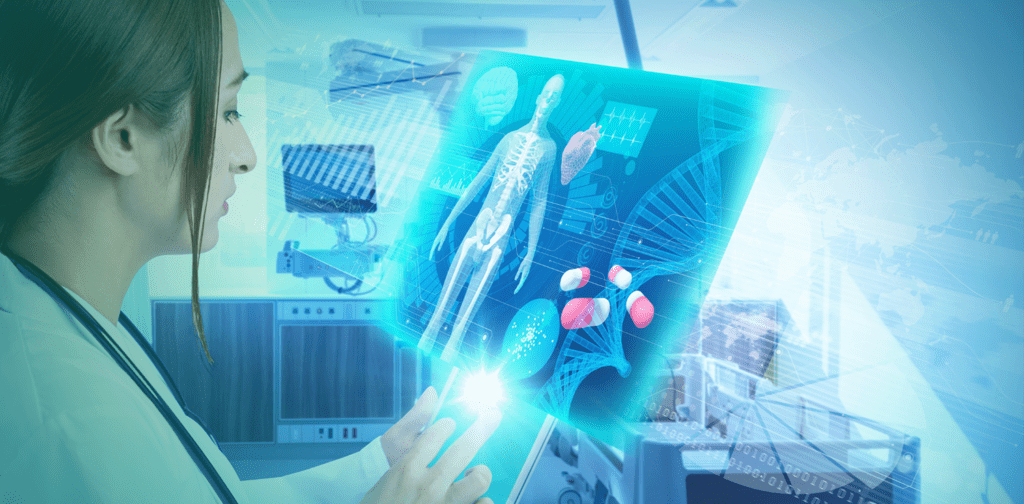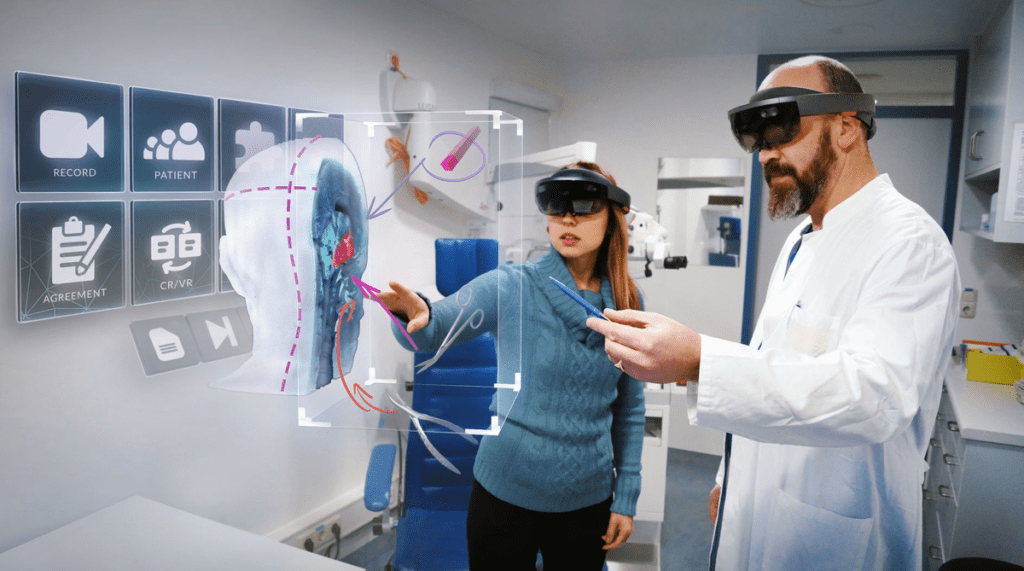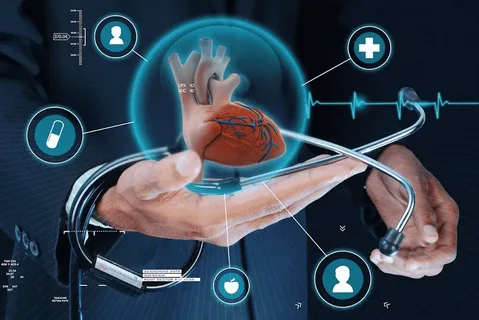Advancements in technology have led to significant improvements in the healthcare sector. Augmented reality (AR) has made notable strides in the evolution of technology.
One of the most worth-seeing applications of AR in healthcare is the augmented reality vein finder.
This device has transformed how healthcare professionals
- Trace veins
- Making procedures more efficient
- Less painful for patients
Let’s dig into the concept in detail and learn how it works, the development of the device, and the notable benefits in healthcare. You will also know the combined effect of VR and AR in the healthcare industry and its possible outcomes.
What Is an Augmented Reality Vein Finder?
An augmented reality vein finder is a medical device that uses AR technology to visualize veins under the skin.
When we combine infrared imaging with augmented reality, the tools project a real-time image of the veins onto the patient’s skin.
This enables healthcare providers to see veins that are otherwise difficult to locate.
How Does Augmented Reality Vein Finder Work?
The operation of an AR vein finder is based on the principles of infrared light absorption and AR projection.
Here’s how it works:
- Infrared Light Emission
It emits infrared light onto the patient’s skin
- Vein Detection
Veins absorb more infrared light than surrounding tissues. This difference in absorption helps the device detect veins.
- Image Processing
The device processes the captured image to enhance clarity and detail.
- AR Projection
The processed image is then projected onto the skin using AR technology.
The projection is in real-time and could be adjusted with the patient’s movements.
This process enables healthcare professionals
- To see veins clearly
- It detects veins even in patients with difficult venous structure
- Eliminate need for multiple needle sticks
- Improve patient comfort

AR vein finder
If you are a game lover, we have detailed article for you on 20 Best VR Headsets, to amplify your gaming experience and also to find a reliable yet cheap Headset.
How Vein Visualization Technology Developed
It is crucial to know that vein visualization technology has a long history and developed in various ways.
With the arrival of augmented reality vein finder, the tracing of the veins had depended closely on the professional ability of the healthcare providers. The traditional method, however, had its drawbacks, especially while dealing with patients whose veins were difficult to locate due to factors such as obesity or dehydration.
The availability of ultrasound machines marked a major advancement since doctors and other practitioners could now observe veins beneath the skin.
However, these machines were large and cumbersome for such processes, and smaller machines were not as versatile or efficient.
AR vein finders have revolutionized this industry by offering a compact, feasible approach with reliable, immediate outcomes.
Benefits of Using AR Vein Finders in Healthcare
The implementation of AR vein finders in healthcare settings offers numerous benefits.
These include:
- Increased Accuracy
AR vein finders significantly improve the accuracy of vein detection, reducing the chances of failed attempts.
- Enhanced Patient Comfort
By minimizing the number of needle sticks, AR vein finders help reduce patient discomfort.
- Time Efficiency
The ability to quickly locate veins saves valuable time during medical procedures.
- Versatility
AR vein finders can be used in various settings, from emergency rooms to routine blood draws, making them versatile tools.
- Training Aid
These devices also serve as valuable training tools for medical students and new healthcare providers, helping them understand vein anatomy more clearly.
Augmented Reality Vein Finders for Pediatric Patients
Pediatric patients often present a unique challenge when it comes to venous access.
These little babies have smaller, less visible veins, and traditional methods are more complex and stressful to trace correctly.
AR vein finders are particularly beneficial in these cases, providing clear visualization of veins and reducing the need for multiple needle sticks.
This technology helps make procedures less traumatic for children and more straightforward for healthcare providers.
Augmented Reality in Healthcare: Beyond Vein Finders
The use of augmented reality in healthcare is not limited to vein finders. AR is increasingly being integrated into various aspects of medical practice, enhancing procedures and improving patient outcomes. Some examples include:
- Surgical Assistance:
Surgeons use AR to overlay critical information, such as the location of arteries or tumors, directly onto the patient’s body during operations. This helps reduce the risk of errors and improve surgical outcomes.
- Medical Training
AR is a powerful tool for medical training, providing students with immersive experiences and allowing them to practice procedures in a controlled environment.
- Patient Education
AR helps patients better understand their medical conditions and treatment options by visualizing complex information in an easy-to-understand format.
If you are interested in art and drawing, kindly explore our latest Manga Owl article to uplift your anime skills and passion.
Comparative Analysis: AR Vein Finders vs. Traditional Methods
Assessment by palpation and observation has been practiced for quite some time, and it used to be a conventional mode of evaluation. However, these methods may not be very effective, especially when the patient has poor veins for puncture.
Ultrasound machines were slightly better, but they were larger, more expensive, and, therefore, not very portable.
In contrast, AR vein finders offer several advantages:
- Ease of Use
These devices are user-friendly and require minimal training compared to ultrasound machines.
- Portability
Augmented Reality vein finders are compact and easy to transport, making them ideal for various medical settings.
- Real-Time Visualization
The real-time projection of veins onto the skin allows quicker and more accurate vein location.
This comparison highlights the benefits of AR vein finders,making them a preferred choice in many healthcare settings.

Challenges and Considerations in Using AR Vein Finders
While AR vein finders offer numerous benefits, there are some challenges and considerations to keep in mind:
- The cost of these devices can be a barrier for some healthcare facilities, particularly smaller clinics and practices.
- Proper training is required to use AR vein finders effectively. Without adequate training, the benefits of the device may not be fully realized.
- Over-reliance on technology could lead to a decline in traditional skills, such as manual vein palpation.
Future of AR Vein Finders and Vein Visualization Technology
The future of vein detection devices looks promising, with ongoing advancements expected to enhance their capabilities further.
Potential developments include:
- AR vein finders may become even smaller and more portable, making them accessible in a wider range of settings, including home healthcare.
- Combining AR technology with artificial intelligence could lead to even greater accuracy and ease of use, making these devices indispensable in healthcare.
- As AR technology continues to evolve, its use in other medical fields, such as sports medicine and veterinary care, is likely to expand.
Combining VR and AR in Healthcare
Combining virtual reality (VR) and augmented reality (AR) is transforming healthcare. This integration offers immersive, interactive experiences for both patients and healthcare providers. Here are some key applications:
- Surgical Training
VR and AR create realistic simulations for surgical training, improving skills without risking patient safety.
- Patient Rehabilitation
These technologies offer engaging, gamified exercises for physical and cognitive rehabilitation.
- Mental Health Therapy
VR provides controlled environments for exposure therapy, helping patients manage anxiety and PTSD.
- Remote Consultations
AR enhances telemedicine by overlaying patient data and imaging during remote consultations, improving diagnostic accuracy.
To Sum Up
The augmented reality vein finder represents a significant advancement in healthcare technology. It offers numerous benefits for patients and healthcare providers. These new technologies are set to transform medical procedures and patient care to a new extent with better outcomes.
As technology continues to evolve, the future of AR in healthcare looks bright, with the potential for even greater innovations on the horizon.
FAQs
How does an augmented reality vein finder work?
An AR vein finder works to depict the vein’s location in the following way;
- Emission of IR light onto the skin
- Absorption of IR light
- Projection of veins image onto the skin using AR
What are the benefits of using AR vein finders in healthcare?
The common benefits include
- Increased accuracy in veins detection,
- Enhanced patient comfort by reducing needle sticks
- Time efficiency in medical procedures
- Versatility across different healthcare settings
- Training alternative for medical professionals
Are there any AR vein finders for pediatric patients?
Yes, some AR vein finders are specifically designed for pediatric patients, featuring adjustable settings and smaller sizes to cater to the needs of younger patients.

